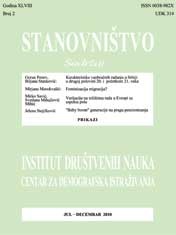Efekti migracionih tokova na tržište rada imigracionih zemalja: primer EU nakon proširenja 2004. godine
Effects of Migration Flows on the Host Country Labour Market Following the 2004 Eu Enlargement
Author(s): Drinka PekovićSubject(s): Migration Studies, Human Resources in Economy
Published by: Институт друштвених наука
Keywords: migration flows; labour market; European Union; unemployment; wage
Summary/Abstract: This paper examines the effects of migration flows on unemployment, employment probabilities and native wages. The analysis contains the evaluation of migration effects of labour from Central and Eastern European countries which became European Union member states in 2004, on old member's labour market. Particular emphasis was placed on evidence of the migration flows impact from the new EU member states on the labour market performances in the United Kingdom and Ireland, the countries which did not restrict the access of new member immigrants to their labour markets. The analysis was realized for the period of 2004 to 2008 when the migration inflow was the largest.The empirical literature suggests that the migration effects on unemployment and employment probabilities of natives are very small. The young and low skilled native workers are more affected by migration flows than other groups of workers. Also, most empirical studies show small negative wage effects of immigration. Although the results of public researches and econometric studies have shown the modest potential labour migration flows from new member states and the small potential effects on EU-15 labour market, twelve out of fifteen old member states decided to apply transitional arrangements. The evidence presented in the report of the European Commission pointed out positive EU labour market impact of modest inflow of immigrants from new member states. Sectoral and skill composition of immigrants from new member states suggests their complementary role on EU labour market. The majority of immigrants from new member states are men, aged between 18 and 34, medium-level of education. Most immigrants have been employed in service sector, manufacturing and construction. The high employment rate of immigrants from new member states (78%) and low unemployment rate (6%) in the post-enlargement period have confirmed positive migration impact on EU labour market performances. The unemployment effects of migration have been smaller than projected. The migration flows from new member states have resulted in negligible increase in EU-15 unemployment rate by 0.02-0.04% and decrease in native wages by 0.08%. In the second part of this paper the migration impact on labour market of the United Kingdom and Ireland is examined. The selective application of transitional measures across EU resulted in substantial diversion of migration flows toward the United Kingdom and Ireland. In the period of 2004-2008, Ireland accepted 448.000 immigrants from new member states and in the United Kingdom 926.000 immigrants are registered in WRS, eight times more than was projected. However, the large migration flows from new member states did not result in substantial disturbances on the labour market. In Ireland the evidence for the existence of displacement native workers by immigrants was found in the hotel and restaurants sector and in manufacturing sector, but there was no consequence in increase of native unemployment. The high economic growth rate in Ireland and the United Kingdom caused the absence of unemployment effects of migration and the appearance of small positive effects on native wages. Research results show that a one percent increase the share of immigrants from new member states in labour force causes negligible increase in native wages by 0,0013% in Ireland and 0,246% in the United Kingdom.
Journal: Stanovništvo
- Issue Year: 49/2011
- Issue No: 2
- Page Range: 51-71
- Page Count: 21
- Language: Serbian

